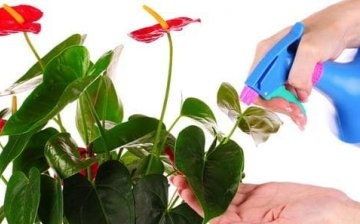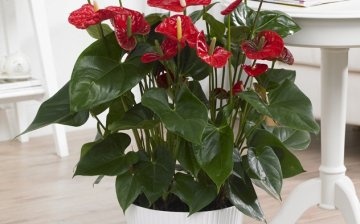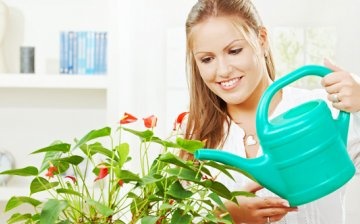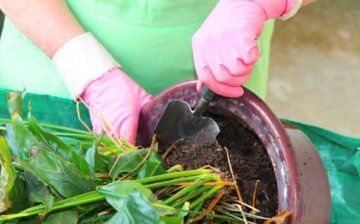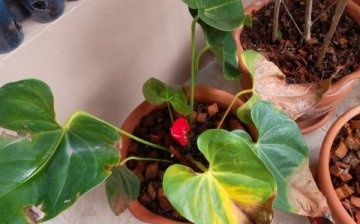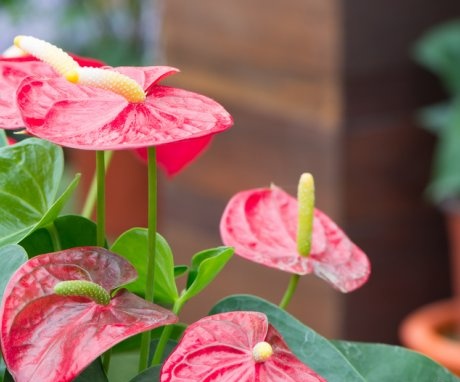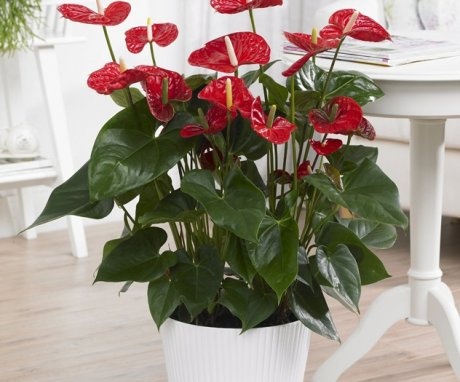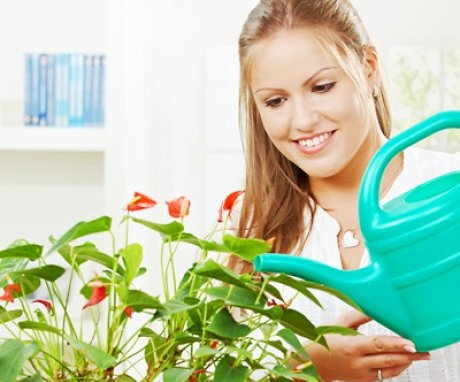Anthurium: proper flower care
Anthurium (Anthurium) is an epiphytic plant, a native of the Aroid family, but the species diversity is so great that you can often find Anthurium, belonging to the genus of vines, herbaceous or semi-epiphytic. The homeland of the flower is the northern and southern American countries with tropical and subtropical climates.
The name of the plant comes from the Greek words anthos and oura, which means flower and tail. This name stuck due to the structure of the flowers: the inflorescences-cobs are shrouded in bright blankets-leaves, the color range of which is very diverse.
Content:
- Distinctive features of the Anthurium flower
- What conditions does the plant prefer?
- Irrigation and fertilization
- When and how to transplant a flower
- How to protect Anthurium from diseases and pests
Distinctive features of the Anthurium flower
Anthurium is also called male happiness. It has spade-shaped, rounded, heart-shaped and dissected matte and glossy sheet plates that are able to unfold towards the sun. Flowers of an interesting structure have a wide range of colors and are painted in various shades: from snow-white to rich red-burgundy and even black. The ear-shaped inflorescence has a conical, clavate, spherical or spiral structure and different colors.
Different varieties of Anthurium have their own aroma: from delicate and barely perceptible to rich and rather sharp.
A feature of the plant is the ability to bloom year-round, but this requires a sufficient amount of light. Flowers can last from one and a half to three months, and when cut, they can stand in water for up to four weeks. And if you provide them with pollination, then fruits-berries are formed, filled with seeds of a golden or rusty color. When Anthurium grows old, its decorative effect is lost - the leaves become smaller, and the trunk, covered with the remnants of petioles, dries up. Therefore, the plant needs to be periodically rejuvenated.
In indoor floriculture, several varieties of Anthurium are most often found:
- Beautifully flowering, prominent representatives of which are "Andre" and "Scherzer", as well as hybrid varieties.
- Variegated, with decorative foliage. This group is represented by Anthurium Crystal, Majestic and their hybrids.
- Green-leaved, which is unpretentious. From this group preference is given to Anthurium "Hooker" and ampelous climbing.
Whichever species lives in the house, you need to try to please the flower and preserve its decorative effect.
What conditions does the plant prefer?
The most difficult thing when growing Anthurium is to create suitable comfortable conditions for its growth, so many people prefer to grow a flower in greenhouses. The plant must be provided with warmth and humidity, as well as sufficient lighting:
- Lighting. Anthurium is a lover of bright, but diffused sunlight. Direct rays can burn the delicate leaves of the flower. Therefore, the best place for the plant will be windows on the east and west sides. You can also place it on the south side, but away from windows, or create diffused lighting. Also, the flower can grow in a shaded corner, but it will not bloom.In order for Anthurium to please with flowering all year round, you need to take care of additional artificial lighting in winter.
- Temperature conditions. Anthurium is a tropical inhabitant, so the optimum temperature for it is 23-28 degrees. In the autumn-winter period, the temperature can drop to 16-18 degrees, and for some species it is required to create cool conditions within 11-14 degrees to ensure a dormant period lasting 2-3 months. But it should be remembered that Anthurium is sensitive to drafts and sudden changes in temperature, so such transitions must be carried out smoothly.
- Humidity level. The tropical climate assumes high humidity, which should be between 85-90%. If these conditions are not met, then Anthurium will show a protest in the form of slow growth and refusal to bloom. It is useful to remove dust from the leaves with a damp sponge, and in summer sprayusing warm, settled water so that the water does not get on the inflorescences, which can become stained and fall off. The sphagnum moss laid out around the trunk helps maintain the required moisture level, from which the aerial roots will take the necessary moisture. You can also place the flowerpot on the moistened pebbles so that it is not submerged in water.
Irrigation and fertilization
Watering Anthurium should be approached competently, because waterlogged or dry soil has a detrimental effect on the plant and leads to the development of diseases. For irrigation, use only warm soft settled or rainwater. The presence of lime in the water should not be allowed, otherwise it will acidify the soil and the leaves will turn yellow. In the warm season, watering is carried out 2-3 times a week, and in the cold - once will be enough.
Immediately after the procedure, you need to drain the excess water from the pan.
Also, the plant should be provided with periodic feeding. The norm specified in the instructions mineral fertilizers, need to be bred in half and applied twice a month in the spring-summer period. When using the foliar fertilization method, the frequency of applications is increased up to three to four times a month.
It is useful to feed in the fall organic: a solution of poultry droppings or mullein, and you can also use leaf humus or rotted manure. Thanks to these conditions, Anthurium will feel at home and will thank you with beautiful flowering and active growth.
When and how to transplant a flower
After purchase, the flower needs to be transplanted into a suitable plastic or glass pot. A clay container will not work, because the roots of the plant grow into its walls, which makes it difficult for further transplants. A drainage layer is laid at the bottom of the pot and fertile soil is covered. In the capacity of which a ready-made orchid soil mixture is used or peat, coniferous and leafy soil, as well as sand are mixed in a ratio of 1: 1: 1: 0.5 and add coniferous bark with charcoal.
To remove a flower from a temporary container, you need to shed the earth well and carefully remove it without damaging the fragile roots. Carefully inspect root system and remove injured and rotten roots, then spray them with phytolavin solution and place in a prepared container, gradually filling them with soil mixture.
It is better to transplant home Anthurium in the spring. This is done for two reasons:
- The capacity has become small and the roots have filled it with themselves so that the soil is almost invisible or the root has come out through the drain hole.
- The planting soil mixture was depleted and whitish or brown spots appeared on its surface.
- Symptoms of decay of the root system are observed.
As practice shows, Anthurium is transplanted every year until the age of four, and an older flower is transplanted every two or three years.
On a note! Anthurium is not afraid of transplanting during the flowering period, so this can be done if necessary.
The main thing is not to injure the delicate roots.Also, the process of replacing the substrate and capacity can be combined with one of the propagation methods and dividing the bush. For the first time, such a procedure can be carried out when the plant is four years old and at the time of complete release from foliage. This usually happens in winter.
The procedure is carried out using a sterile sharp knife, with which you need to divide the root into two or three parts so that the leaves and buds are evenly spaced and each one is planted in separate containers. After transplanting, you should not feed the plants during the adaptation period, about two weeks. Watering should be limited and, if necessary, tie the plant to a support.
How to protect Anthurium from diseases and pests
Anthurium always signals its condition, and if a depressed state was noticed, a suspension in growth and development, crushing of leaves and a lack of shine on them, then you need to pay more attention to the plant. But when all the necessary care measures have been taken, and the condition of the flower is deteriorating, this is an alarming signal and, perhaps, the pet is sick.
There can be several reasons for the disease:
- Smallpox. On the leaf plate, spots of yellow-green color with a convex surface are formed. The disease can be caused by insufficiently high temperature with constantly high humidity, irregular application fertilizers or injury to the root system.
- Enations. The leaves are overgrown with growths and bend, the plant does not develop correctly. To date, the causes of the disease are unclear, but experts suggest that it is associated with abrupt changes in temperature and humidity conditions.
- Bronze of foliage. A viral disease in which partial discoloration of the leaf plate occurs and small holes are formed. At the same time, the sheets can become coarse and wrinkled. Control measures include the complete destruction of the affected plant, and prevention is the identification and destruction of thrips - carriers of the virus.
- Stem rot. On the stems and leaves, watery putrefactive spots of a dark color are formed, which lead to the death of the affected parts of the plant. The struggle consists in the complete isolation of diseased flowers and is treated with the preparations "Rovral" or "Saprol" and biologics "Fitosporin-A" or "Alirin-B". If the treatments did not bring results, then the plant must be destroyed. Prevention consists in full-fledged competent flower care.
- Fusarium wilting. This is a fungal disease in which there is a rapid wilting of the leaves, which turn yellow and fall. The zone of the root neck is covered with a white-pinkish bloom. When watering, fungal spores spread throughout the plant. There are no remedies to combat this ailment, and hygiene should be observed for prevention: use clean planting containers and disinfected soil.
- Septoria leaf spot. It is characterized by the formation of brown uneven spots on the leaf plate, bordered by a yellowish strip. The fight is aimed at removing the affected parts of the plant, which are subsequently burned. Indoor humidity is lowered, micronutrient levels are normalized and pests are eliminated. If the disease is not started, then they are treated with special drugs. Prevention consists in proper care of the flower and the destruction of harmful insects.
Of the pests, Anthurium can be attacked aphids, scale insects, spider mites, thrips, greenhouse and tobacco whiteflies. As a struggle, various chemicals and folk remedies are used. Severely affected plant parts should be removed and destroyed. And prevention is the creation of comfortable conditions and the implementation of full-fledged care. You should also regularly inspect all plants living in the house and carry out preventive spraying.
If you provide Anthurium full care, then he will be able to delight the owner with beautiful flowers all year round. But at the same time, it should be remembered that plants also need rest, so they need to arrange such periods to restore and accumulate strength. In order for Anthurium to bloom year-round in the house, several species of this plant should be introduced.
More information can be found in the video:



